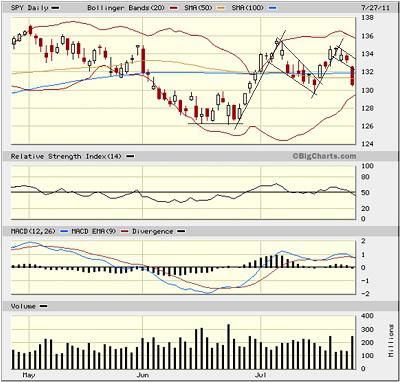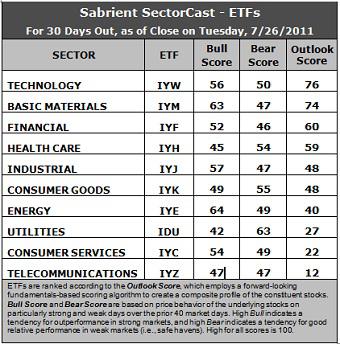Courtesy of Scott Martindale, Senior Managing Director, Sabrient

Heretofore, strong corporate earnings have trumped any negative in the economic reports and other problems around the globe. But investors have suddenly fled despite strong reports from the likes of market leaders Apple (AAPL), IBM (IBM), Microsoft (MSFT), and Coca Cola (KO) last week, and others like Cummins (CMI), Baidu (BIDU), Broadcom (BRCM), amazon.com (AMZN), Las Vegas Sands (LVS), and Boeing (BA) this week.
The Tech sector resumed its leadership position last week, as a bull market usually demands, but that goes both ways as it led to the downside in today’s (Wednesday) selloff. This time Apple (AAPL) wasn’t there to provide support. An adverse ruling from the International Trade Commission on patent infringement sent Apple back below $400. But the bigger culprit this week overall has been Industrial (IYJ), which is down almost 4% from Friday’s close to Wednesday’s close. Notably, Internet-oriented IPOs continue to garner plenty of interest. Last week it was Zillow (Z), and today it was Dunkin Brands (DNKN).
I think we’re going to get some kind of deal passed in time to stave off a crisis…and I think that Fitch, Moody’s, and S&P are highly unlikely to downgrade U.S. debt to AA (as they have said they might no matter what happens with the debt ceiling), simply because of the far-reaching ramifications of such a move.
Looking at the SPY chart, it took seven days to consolidate previous gains (from the June double-bottom rally) within a bull flag (or pennant) pattern. Although it lost support at the convergence of the 50- and 100-day simple moving averages, the lower trend line of the bull flag held, and we got the upside resolution last Tuesday that I expected. However, the week closed with a potentially bearish hanging man candlestick on Friday, and then of course, we got word that the debt deal-making had failed.

Nevertheless, price seemed to be consolidating on Monday and Tuesday in what might have become another bull flag (although at a lower high than the prior one), but today gave us outright failure of any developing bull flag, as well as of the 50- and 100-day simple moving averages. RSI and MACD are crossing over bearishly, and volume was as strong today on the selloff as it was on the big rally we had last Thursday. Let’s see if further weakness on Thursday confirms the technical weakness, or if this is simply a panic-sale that will quickly become a buying opportunity for nimble traders.
The TED spread (i.e., indicator of credit risk in the general economy, measuring the difference between the 3-month T-bill and 3-month LIBOR interest rates) closed at 17.66, which was down a hefty 5.3% today (Wednesday) alone. It appears that investors were fleeing stocks in favor of corporate bonds. Similarly, the CBOE market volatility index (VIX) closed at 22.98 today, which is the highest close since March 18.
Latest rankings: The table ranks each of the ten U.S. industrial sector iShares (ETFs) by Sabrient’s proprietary Outlook Score, which employs a forward-looking, fundamentals-based, quantitative algorithm to create a bottom-up composite profile of the constituent stocks within the ETF. In addition, the table also shows Sabrient’s proprietary Bull Score and Bear Score for each ETF.
High Bull score indicates that stocks within the ETF have tended recently toward relative outperformance during particularly strong market periods, while a high Bear score indicates that stocks within the ETF have tended to hold up relatively well during particularly weak market periods. Bull and Bear are backward-looking indicators of recent sentiment trend.
As a group, these three scores can be quite helpful for positioning a portfolio for a given set of anticipated market conditions.

A few changes in the rankings this week. Here are some observations about Sabrient’s latest SectorCast scores.
1. Basic Materials (IYM) and Technology (IYW) are still the leaders, although they switched places this week, with IYW now in the lead with an Outlook score of 76 and IYM scoring a 74. Stocks within IYW got a big boost in analyst upgrades in light of some of the positive earnings reports from the sector.
2. Financial (IYF) got a 15 point boost in its Outlook score to take third place, as analysts have suddenly come out with a flurry of upgrades, after languishing at the bottom of this important metric. After finally retaking its 50-day moving average, today’s selloff pushing it back down below. We’ll see if there is any resilience.
3. Healthcare (IYH) continues its fall from grace, as uncertainty abounds around how much of the Federal spending cuts will be placed upon this sector.
4. Utilities (IDU), Consumer Services (IYC), and Telecom (IYZ) remain at the bottom. IYC didn’t get as much relative support from the analyst community, and despite having one of the highest projected long-term growth rates, it is still held back by the worst return on sales (poor margins) and a high projected P/E.
5. Overall, the Outlook rankings have moved this week to slightly more bullish slant, with Tech gained renewed support and Financial rising in the rankings. I’d like to see Energy and Industrial above 50, along with a slight improvement in Consumer Services, to create a decidedly bullish ranking.
6. Looking at the Bull scores, Energy and Basic Materials are clearly the leaders on strong market days, scoring 64 and 63. Utilities is by far the weakest with a 42.
7. As for the Bear scores, Utilities is the clear investor favorite on weak market days with a score of 63, followed by Consumer Goods and Healthcare (although this week’s poor performance so far might change that). The other seven sectors are now pretty much all lumped together with the weaker Bear scores, although Financial has the lowest at 46.
Overall, Basic Materials (IYM) still displays the best combination of Outlook/Bull/Bear scores. Adding up the three scores gives it a total score of 184. Energy (IYE) continues to have the best combination of Bull/Bear with a total score of 113.
Top ranked stocks in Basic Materials and Technology include Rockwood Holdings (ROC), Vale S.A. (VALE), Baidu (BIDU), and Broadcom (BRCM).
Low ranked stocks in Consumer Services and Telecom include Corinthian Colleges (COCO), Media General (MEG), Leap Wireless (LEAP), and Globalstar (GSAT).
These scores represent the view that the Basic Materials and Technology sectors may be relatively undervalued overall, while Consumer Services and Telecom sectors may be relatively overvalued, based on our 1-3 month forward look.
Disclosure: Author has no positions in stocks or ETFs mentioned.
About SectorCast: Rankings are based on Sabrient’s SectorCast model, which builds a composite profile of each equity ETF based on bottom-up scoring of the constituent stocks. The Outlook Score employs a fundamentals-based multi-factor approach considering forward valuation, earnings growth prospects, Wall Street analysts’ consensus revisions, accounting practices, and various return ratios. It has tested to be highly predictive for identifying the best (most undervalued) and worst (most overvalued) sectors, with a one-month forward look.
Bull Score and Bear Score are based on the price behavior of the underlying stocks on particularly strong and weak days during the prior 40 market days. They reflect investor sentiment toward the stocks (on a relative basis) as either aggressive plays or safe havens. So, a high Bull score indicates that stocks within the ETF have tended recently toward relative outperformance during particularly strong market periods, while a high Bear score indicates that stocks within the ETF have tended to hold up relatively well during particularly weak market periods.
Thus, ETFs with high Bull scores generally perform better when the market is hot, ETFs with high Bear scores generally perform better when the market is weak, and ETFs with high Outlook scores generally perform well over time in various market conditions.
Of course, each ETF has a unique set of constituent stocks, so the sectors represented will score differently depending upon which set of ETFs is used. For Sector Detector, I use ten iShares ETFs representing the major U.S. business sectors.
About Trading Strategies: There are various ways to trade these rankings. First, you might run a sector rotation strategy in which you buy long the top 2-4 ETFs from SectorCast-ETF, rebalancing either on a fixed schedule (e.g., monthly or quarterly) or when the rankings change significantly. Another alternative is to enhance a position in the SPDR Trust exchange-traded fund (SPY) depending upon your market bias. If you are bullish on the broad market, you can go long the SPY and enhance it with additional long positions in the top-ranked sector ETFs. Conversely, if you are bearish and short (or buy puts on) the SPY, you could also consider shorting the two lowest-ranked sector ETFs to enhance your short bias.

